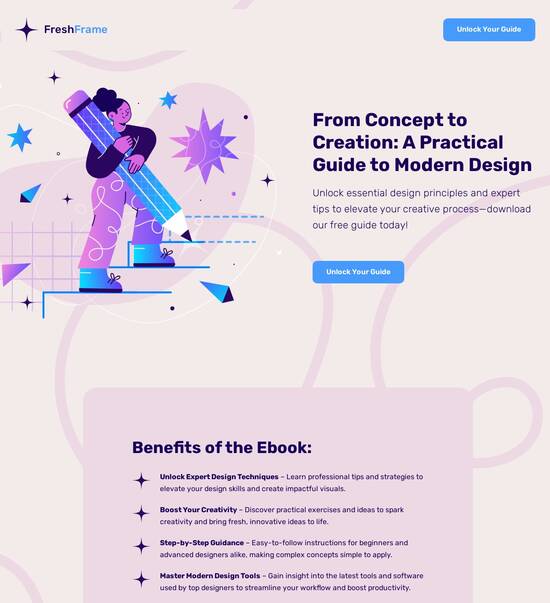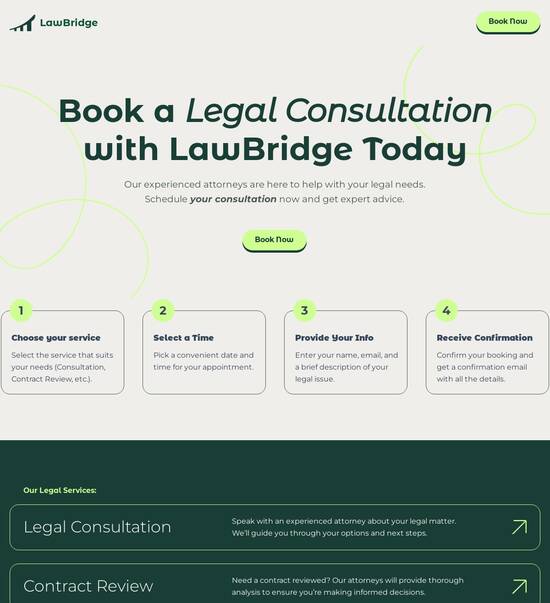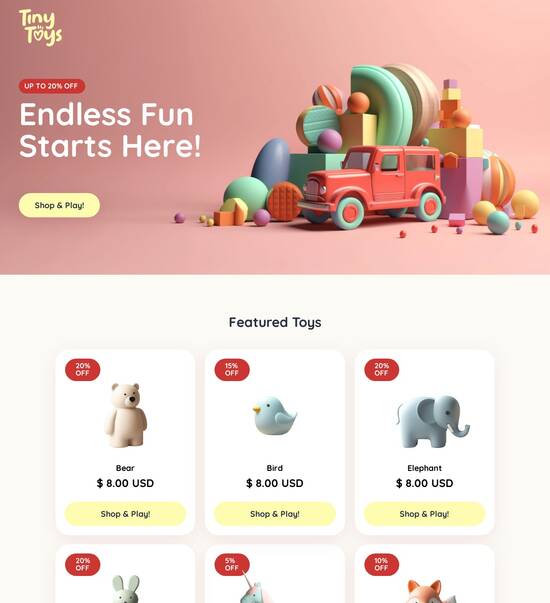
Laravel optimized portfolio page template
Explore Similar TemplatesAbout template
Supercharge your portfolio page with Laravel for outstanding performance! Learn more today.
Recommended templates

Easy to build without coding
With the intuitive drag-and-drop builder, anyone on your team can create high-converting pages without any knowledge of code or design. Make enhancements to your landing page with custom widgets using Javascript, HTML/CSS, or third-party scripts.

Multiple layouts for any industry and goal
Select from 500+ landing page layouts built to boost conversions across industry-specific scenarios. Customize them by adjusting fonts, adding images, and generating on-brand content with the AI assistant. Quickly scale with Instablocks® and Global Blocks that you can save, reuse, and update globally.

Loads fast and looks polished on any device
Every template is responsive, which means they present professionally on any device and load blazingly fast with our Thor Render Engine. You can also power them up with Google AMP technology to deliver an unparalleled mobile experience and drive higher conversions.

Robust analytics & experimentation
Get real-time updates and reporting across all your devices, showing the number of visitors, conversions, cost-per-visitor, and cost-per-lead. Launch AI-powered experiments, run A/B tests, and use heatmaps to analyze user behavior, then optimize your landing page to maximize conversions.







Easy to build without coding
With the intuitive drag-and-drop builder, anyone on your team can create high-converting pages without any knowledge of code or design. Make enhancements to your landing page with custom widgets using Javascript, HTML/CSS, or third-party scripts.
Multiple layouts for any industry and goal
Select from 500+ landing page layouts built to boost conversions across industry-specific scenarios. Customize them by adjusting fonts, adding images, and generating on-brand content with the AI assistant. Quickly scale with Instablocks® and Global Blocks that you can save, reuse, and update globally.
Loads fast and looks polished on any device
Every template is responsive, which means they present professionally on any device and load blazingly fast with our Thor Render Engine.
Robust analytics & experimentation
Get real-time updates and reporting across all your devices, showing the number of visitors, conversions, cost-per-visitor, and cost-per-lead. Launch AI-powered experiments, run A/B tests, and use heatmaps to analyze user behavior, then optimize your landing page to maximize conversions.
All the features you need to build lead-generating landing pages
Explore more featuresLearn how to build top-performing landing pages for any goal
FAQs
Leading the way in building high-performing landing pages





A step-by-step guide to maximizing lead generation with Instapage
Instapage offers a comprehensive approach to creating high-converting landing pages that are crucial for optimizing your marketing campaigns. By utilizing its robust features, marketers can accelerate lead generation and improve ROI effectively. This guide walks you through essential steps for leveraging Instapage to its fullest potential.
Understanding your audience
The first step in utilizing Instapage is understanding your target audience. This involves researching demographics, interests, and behaviors specific to your industry, such as tech or education. Tailoring your messages to align with your audiences' needs enhances engagement and improves conversion rates.
- Identify key segments: Break down your audience into segments for more targeted messaging.
- Analyze user behavior: Use tools to track how your audience interacts with your site.
- Create buyer personas: Develop detailed profiles to guide your landing page content.
Choosing the right templates
Instapage provides over 100 pre-built, high-converting templates that can save you time while ensuring design quality. Choose templates that align with your campaign goals and audience expectations.
- Select conversion-focused designs: Opt for layouts designed specifically for your KPIs.
- Review template responsiveness: Ensure templates work on all devices to reach all users.
- Test multiple templates: Use A/B testing to find which designs resonate best with your audience.
Implementing personalization techniques
Personalization can significantly elevate the effectiveness of your landing pages. Instapage enables dynamic text replacement and audience-specific content to ensure relevance.
- Dynamic text replacement: Adjust headline and content based on traffic parameters.
- Use AdMaps: Align specific ads to customized landing pages for a seamless user journey.
- Monitor audience engagement: Utilize metrics to understand how personalized content performs.
Optimizing for conversions
Once your landing pages are live, use the built-in analytics and experimentation features in Instapage to refine performance and boost conversions.
- Conduct A/B testing: Regularly test different versions of your landing pages.
- Analyze heatmaps: Gain insights into user interactions to identify areas for improvement.
- Track key performance indicators: Focus on conversions, bounce rates, and time on page for a thorough analysis.
By following this structured approach, you can optimize your campaigns and maximize ROI using Instapage's advanced tools.
Start transforming your marketing efforts today by using Instapage to create landing pages that not only attract but also convert leads effectively.
Unleashing the power of a Laravel optimized portfolio page template
Understanding the essence of Laravel as a framework
Laravel is a PHP framework that has gained immense popularity among developers for its elegant syntax and robust features. At its core, Laravel operates on the Model-View-Controller (MVC) architecture, which promotes a clear separation of logic, presentation, and data layers. This structure not only enhances code organization but also facilitates collaborative team efforts. Additionally, Laravel includes built-in security measures such as protection against SQL injection and cross-site scripting, which are crucial for any web application where sensitive data is involved.
Moreover, Laravel's routing capabilities allow developers to create SEO-friendly URLs and manage complex routing logic with ease. With powerful tools at their disposal, developers can focus on crafting visually appealing portfolio pages without getting bogged down by repetitive code. As a versatile framework, Laravel enables developers to implement various features with minimal effort.
MVC architecture for better code organization.
Built-in security measures for data protection.
Robust routing capabilities for SEO-friendly navigation.
Why choose Laravel for portfolio development?
When it comes to portfolio development, Laravel proves to be a superior choice for several reasons. One key advantage is its scalability. As personal brands evolve, business needs shift, or portfolios grow, Laravel provides the flexibility to enhance existing projects easily. With this adaptability, developers can ensure that their portfolio remains relevant and effective in showcasing their skills.
Another significant benefit is the active community support that Laravel enjoys. This expansive network of developers and abundant documentation enables users to find solutions to common problems quickly. Also, Laravel's efficient development processes allow for quicker turnarounds, saving both time and resources. Thus, for marketing departments looking to craft effective portfolio solutions, Laravel is an optimal choice.
Crafting a visually engaging portfolio layout
The layout of a portfolio plays a vital role in user engagement. First impressions matter, and a well-designed layout can significantly influence how visitors perceive a creator's work. An engaging portfolio helps to visually communicate the creator’s brand, while a poorly designed one can deter potential clients. Therefore, it is essential to prioritize layout design for maximum impact.
Choosing between a responsive layout versus a fixed one is also crucial. Responsive designs adapt gracefully to different screen sizes, ensuring accessibility across devices. This flexibility is particularly advantageous, as statistics show that a growing number of users browse from mobile devices. Therefore, an adaptable portfolio can significantly enhance user experience, making it easier for visitors to navigate and engage with content.
Hero section for showcasing standout work.
Project showcase grids for organized presentation.
Testimonials to establish credibility and trust.
Key layout components for user-centric design
In creating a user-centric design, it’s essential to include key layout components. The hero section is often the first thing visitors see, making it an opportunity to highlight impressive works or achievements. This prominent placement can capture attention and effectively communicate the creator’s unique value proposition.
In addition, displaying projects in well-organized grids allows users to browse through works easily. Utilizing testimonials and social proof reinforces trust, which is vital when potential clients evaluate a portfolio. Ultimately, prioritizing these design components can lead to a more engaging and effective portfolio.
Essential components for a Laravel portfolio page
To make the most out of a Laravel optimized portfolio page, several essential components must be implemented. Dynamic project presentations are crucial, allowing users to filter and categorize work based on type, skills, or industries. Having such interactive filters can elevate the user experience, making it easy for potential clients to find relevant projects quickly.
Incorporating interactive sliders or carousels can also enhance visibility by showcasing multiple projects in a limited space. Users can navigate seamlessly through featured works without overwhelming them with information. Combining these elements results in a rich, engaging experience for visitors exploring the portfolio.
Dynamic presentations with filtering options.
Interactive sliders for enhanced project visibility.
Customization through Blade templates
Laravel's Blade templating engine provides an efficient way to customize portfolio pages. Blade's syntax allows developers to create reusable template components, which can save valuable time and ensure consistency across the portfolio. This feature enhances the maintainability of the portfolio as developers can make changes centralized without needing to update each instance manually.
Using Blade for modular designs promotes organized code structures. Components such as headers, footers, and project cards can be created as standalone elements. Such a strategy not only streamlines development but also enables frontend designers to work on individual components without the risk of affecting the whole template.
Implementing advanced features for enhanced user experience
To significantly improve user experience on portfolio pages, integrating advanced features is essential. Popular Laravel plugins can extend functionality, offering capabilities like animations, enhanced user interactions, and more refined project showcases. Utilizing these plugins allows developers to focus on experimenting with creative elements rather than reinventing the wheel.
Moreover, features such as AJAX can facilitate synchronous loading, ensuring that users don't have to refresh the page to see new content. This fluid interaction can make browsing portfolios more enjoyable and seamless. Overall, implementing these advanced features is crucial for modern portfolio pages.
Integrate popular plugins for functionality enhancement.
Use AJAX for smoother interactions.
Security considerations in portfolio development
Security is a vital aspect to consider when developing a portfolio page, especially if it features interactive elements or collects sensitive data. Implementing encryption protocols ensures that data remains secure. This becomes increasingly important as more users engage with portfolios, and creators may start collecting personal information through contact forms.
Additionally, setting up authentication for private projects can protect sensitive content that needs to be showcased to select clients. By establishing these security measures, portfolio creators can maintain user trust, which is critical in the age of data privacy concerns.
Optimizing performance across devices and screen sizes
Optimizing performance across various devices is essential in today’s web development landscape. Statistics reveal that a significant portion of internet traffic comes from mobile devices. Therefore, ensuring that portfolios load and display effectively on smartphones, tablets, and desktops should be a top priority. A well-optimized site is not only user-friendly but can also improve search engine rankings.
To achieve this, developers can implement responsive design techniques, ensuring that all components of the portfolio scale appropriately regardless of the user's screen size. It’s also wise to adopt performance optimization techniques, such as lazy loading for images and videos, which only load content when it enters the viewport, minimizing initial load times.
Ensure responsive design for mobile optimization.
Implement lazy loading for faster access.
Minimize CSS and JavaScript assets to speed up loading.
Navigating the development process: Laravel project best practices
Embarking on a portfolio project involves careful planning and an understanding of best practices. Creating wireframes provides a visual representation of the project’s structure, helping to identify essential elements before actual coding begins. This approach allows developers to map out the user experience strategically, resulting in focused outcomes that align with project goals.
Defining specific goals and identifying the target audience for the portfolio are also crucial steps. These factors contribute to effective design choices, aligning the portfolio’s intent with the viewer's expectations. Additionally, establishing a foundation with clear objectives can guide decisions throughout the development process.
Plan project components through wireframes.
Define goals and determine your target audience.
Testing and debugging in Laravel
Laravel offers built-in testing capabilities that are immensely beneficial during the development process. The framework’s testing suite allows developers to run comprehensive tests, identifying potential flaws before launching the portfolio. This practice enhances overall quality by ensuring the site functions optimally and meets user expectations when it goes live.
Common pitfalls can arise during development, such as broken links, misaligned elements, and unsolvable bugs. However, adopting a systematic approach to testing can combat these issues effectively. Iterating on feedback and addressing identified concerns leads to a polished final product. These practices are essential for any developer seeking to deliver a high-quality Laravel portfolio.
Leveraging documentation for continuous improvement
Laravel's extensive documentation serves as a valuable resource for both novice and experienced developers. Navigating the documentation effectively enables users to discover best practices, design patterns, and new features released in recent updates. Staying informed through official documentation is critical for optimizing development workflows and maintaining code quality.
Keeping up-to-date with framework updates, especially concerning security patches, is paramount in an evolving web environment. By regularly checking Laravel's documentation, developers can learn about new enhancements and adopt modern features to improve their projects continually.
Utilize documentation as a vital learning tool.
Stay updated on framework changes and best practices.
Community resources and support networks
Engaging with the Laravel community can significantly enhance problem-solving capabilities. Forums and social media groups provide platforms for sharing experiences, asking for help, and collaborating on projects. Accessing these community resources allows developers to glean insights from others' experiences and find solutions to common issues, creating a more supportive development environment.
Moreover, exploring open-source portfolio projects can provide inspiration and ideas that can be adapted to individual portfolios. This exposure to diverse approaches can help developers refine their styles and techniques while benefitting from the creativity of others.
The role of A/B testing and analytics in portfolio optimization
Understanding user behavior is fundamental to optimizing portfolio pages effectively. Analytics tools like Google Analytics can offer insights into how visitors interact with the site. Setting up tracking for key performance indicators allows developers to identify areas for improvement based on real-world data.
A/B testing provides another effective method for refining portfolio design. By testing variants of layout designs, color schemes, and call-to-action placements, developers can gather critical data on what resonates best with their audience. Continuous measurement of these metrics ensures that portfolios evolve to meet user preferences, thereby improving engagement and conversion rates.
Set up analytics tools for comprehensive user monitoring.
Conduct A/B tests on key portfolio elements.
Future-proofing your Laravel portfolio
Future-proofing a Laravel portfolio is crucial, especially considering the rapid evolution of web technologies. Staying current with design trends and development best practices can ensure that a portfolio remains competitive and appealing to prospective clients. Regularly revising design principles and being open to integrating new tools and frameworks can foster sustained relevance in the crowded digital landscape.
Expanding functionality through API integrations is another important factor in future-proofing. Incorporating third-party services can enhance a portfolio's capabilities, ranging from enabling online purchasing options to connecting with social media platforms. By considering future functionalities users might expect, developers can design adaptable portfolios to accommodate these needs.
Keep updated with new design trends and development techniques.
Utilize API integrations for enhanced functionality.
Showcasing real-life examples of successful Laravel portfolios
Analyzing successful Laravel portfolio projects can provide valuable insights into effective design and functionality. For instance, many top portfolios leverage innovative layouts that emphasize user experience while effectively highlighting their work. By studying these real-world implementations, developers can identify best practices, design trends, and features that contribute to a portfolio's success.
Additionally, gathering user testimonials can illustrate the impact of aesthetically pleasing designs. Positive feedback from users who have interacted with various portfolio designs can highlight effective elements that resonate well with audiences. Specifically, learning how design influences user perceptions can inspire portfolio creators to adopt similar strategies in their projects.
Analyze design and functionality of successful portfolios.
Collect user testimonials to assess design impact.
Ready to skyrocket conversions?
Supercharge your ad campaigns with high-performing landing pages
Get started














